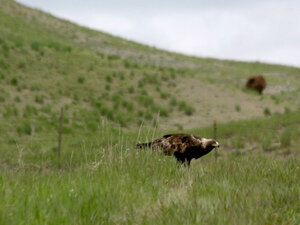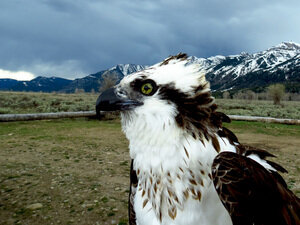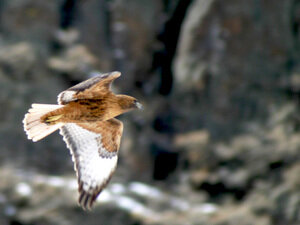Raptor Migrations
Migrations are important achievements in the avian community, linking breeding ranges with areas used to enhance over-winter survival. Identifying key migratory routes and wintering ranges is a vital piece to long-term conservation of any migratory species. Even though many of the raptors we study spend summers in protected areas such as Grand Teton National Park, threats along migratory pathways, stop-over sites, and wintering areas can adversely affect these species. As part of several different projects, we have been documenting migration routes of several raptor species, including Ospreys, Rough-legged Hawks, Red-tailed Hawks, and Bald Eagles.
Osprey
Beginning in the summer of 2010, Craighead Beringia South partnered with Grand Teton National Park (GTNP) to study Osprey migration. This study is part of a larger effort by the National Park Service to better understand the migration of animals that spend only part of each year in the park. Steve Cain, GTNP Senior Wildlife Biologist, sums up the project: "If we want to preserve the biodiversity of the park, we need to be looking beyond the borders and working with a variety of partners and stakeholders to preserve these migrations." This project has been completed and we are in the final phases of analyzing the data.
Red-Tailed Hawk
Natural selection acts on Red-tailed Hawks throughout the annual cycle. Events during each phase of the cycle of a long distance migrant like the Red-tailed Hawk are likely to influence those in subsequent phases. Events that may have important influences include: changing, or loss of, winter habitat; juveniles from this population not returning to breed as adults; exposure to potentially toxic substances; and mortality of birds during migration and/or on wintering areas. As predators at the top of food webs, Red-tailed Hawks are bellwethers to environmental change. There is a great deal of concern about declines in neo-tropical migrant bird populations. This study was undertaken to learn how events that occur during the migration and wintering period affect Red-tailed hawk reproductive success in Grand Teton National Park.
Read our manuscript summarizing the migratory patterns of our tracked Red-tailed Hawks here.
Bald Eagle
As part of our study on lead ingestion in Bald Eagles from Jackson Hole, we outfitted many Bald Eagles with satellite transmitters to document how our local management was affecting this migratory raptor. With this data, we have also been investigating the migratory behaviors of Bald Eagles breeding in Canada and wintering in Jackson Hole and in Sublette County, Wyoming.
Publications:
Winter ecology of Red-tailed Hawks from northwestern Wyoming. Study objectives and field methodologies. (2000). Craighead, D. J., Smith, R. S. N., Cain, H. S. CBS.
Migration and winter ecology of four red-tailed hawks determined by satellite telemetry. (2000). Craighead, D. J., Smith, R. S. N., Cain, H. S. CBS.
Red-tailed Hawk winter habitat assessment. (2001). Craighead, D. J., Lindquist, E., Smith, R. N. CBS.
Accuracy assessment of Argos PTT locations for tracking red-tailed hawks. (2004). Craighead, D., Smith, R. N. Raptor Research Foundation - California Hawking Club 2004 Annual Meeting.
Lead Exposure in Bald Eagles from Big Game Hunting, the Continental Implications and Successful Mitigation Efforts. (2012). Bedrosian, B., Craighead, D., Crandall, R. PLoS One. 7: e51978.
Migratory pathways, timing, and home range of southern Greater Yellowstone Osprey. (2015). Bedrosian, B., Cain, S., Wolff, S., Craighead, D. Journal of Raptor Research, 49, 325-332.
Migration of Red-tailed Hawks (Buteo Jamaicensis) from northwest Wyoming. (2016). Craighead, D., Crandall, R. H., Smith, R. N., Cain, S. L. The Wilson Journal of Ornithology, 128(1), 150-158.
Migratory behavior and seasonal home range estimates for bald eagles using the Rocky Mountain Flyway Bedrosian, B., Crandall, R., Craighead, D.

Not all Bald Eagles migrate, but many make long seasonal migrations trips.

In our study Golden Eagles did not make long migrations but did make seasonal movements presumably to find available winter food.

Osprey's from this study migrated to both the Caribbean and Mexico, both nice places to spend the winter.

Red-tailed Hawk migrated from Wyoming to Mexico and even further south. One bird's wintering area was 2,000 miles from it's nesting territory in Northwest Wyoming.




